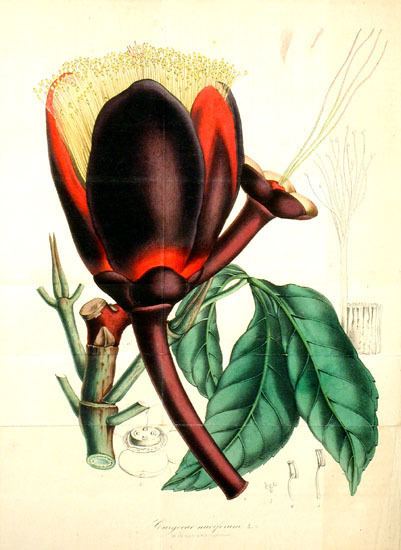 | ||
The Flora of Colombia is characterized by 130,000 species of plants that have been described within Colombian territory.
Contents
- National flower of Colombia
- National Tree of Colombia
- Endemism
- Ecoregions with high endemism
- Tree species
- Abarema
- Acidocroton
- Aiphanes
- Aniba
- Brownea
- Brunellia
- Calatola
- Centronia
- Ceroxylon
- Clusia
- Eschweilera
- Freziera
- Grias
- Guarea
- Gustavia
- Herrania
- Huilaea
- Inga
- Leptolejeunea
- Licania
- Macrolobium
- Magnolia
- Mayna
- Meriania
- Metteniusa
- Miconia
- Oenocarpus
- Orphanodendron
- Parmentiera
- Passiflora
- Phytelephas
- Pouteria
- Pradosia
- Prunus
- Rinorea
- Rollinia
- Romeroa
- Schoenocephalium
- Solanum
- Sphaerolejeunea
- Streptosolen
- Swartzia
- Utricularia
- Vantanea
- Wettinia
- Xylosma
- Zamia
- Zygia
- Orchid species
- Frondaria
- Restrepia
- References
National flower of Colombia
The national flower of Colombia is the orchid Cattleya trianae which was named after the Colombian naturalist José Jerónimo Triana. The orchid was selected by botanist Emilio Robledo, in representation of the Colombian Academy of History to determine the most representative flowering plant of Colombia. He described it as one of the most beautiful flowers in the world and selected Cattleya trianae as National symbol.
National Tree of Colombia
The national tree of Colombia is the palm Ceroxylon quindiuense (Quindío Wax Palm) which was named after the Colombian Department of Quindío where is located the Cocora valley, only habitat of this restricted range specie. The Wax palm was selected as the national tree by the government of Belisario Betancur and was the first tree officially declared as a protected species in Colombia. C. quindiuense is the only palm that grows at high altitudes and is the tallest monocot in the world.
Endemism
Colombia has the largest amount of endemic species (species that are not found naturally anywhere else) worldwide. About 10% of the species in the world live in Colombia. Some determinant factors in the distribution range of the species are the weather conditions, temperature, humidity and sunlight availability.
Endemics can easily become endangered or extinct due to their restricted habitat and vulnerability to the actions of man, including the introduction of new organisms.
Ecoregions with high endemism
According to the Colombian Ministry of Environment, the following ecoregions have the highest percentage of botanic endemic species:
Tree species
Many of the Colombian trees are endangered species due to the high quality of the woods and timber industry exploitation (such as Colombian oak Quercus humboldtidiana and Colombian mahogany) and as source of tanning substances for the leather industry (such as mangrove and Encenillo tree Weinmannia tomentosa). Some tree species described in Colombia are:
Abarema
Acidocroton
Aiphanes
Aniba
Brownea
Brunellia
Calatola
Centronia
Ceroxylon
Clusia
Eschweilera
Freziera
Grias
Guarea
Gustavia
Herrania
Huilaea
Inga
Leptolejeunea
Licania
Macrolobium
Magnolia
Mayna
Meriania
Metteniusa
Miconia
Oenocarpus
Orphanodendron
Parmentiera
Passiflora
Phytelephas
Pouteria
Pradosia
Prunus
Rinorea
Rollinia
Romeroa
Schoenocephalium
Solanum
Sphaerolejeunea
Streptosolen
Swartzia
Utricularia
Vantanea
Wettinia
Xylosma
Zamia
Zygia
Orchid species
Colombia has the largest number of orchids in the world. Among others:
